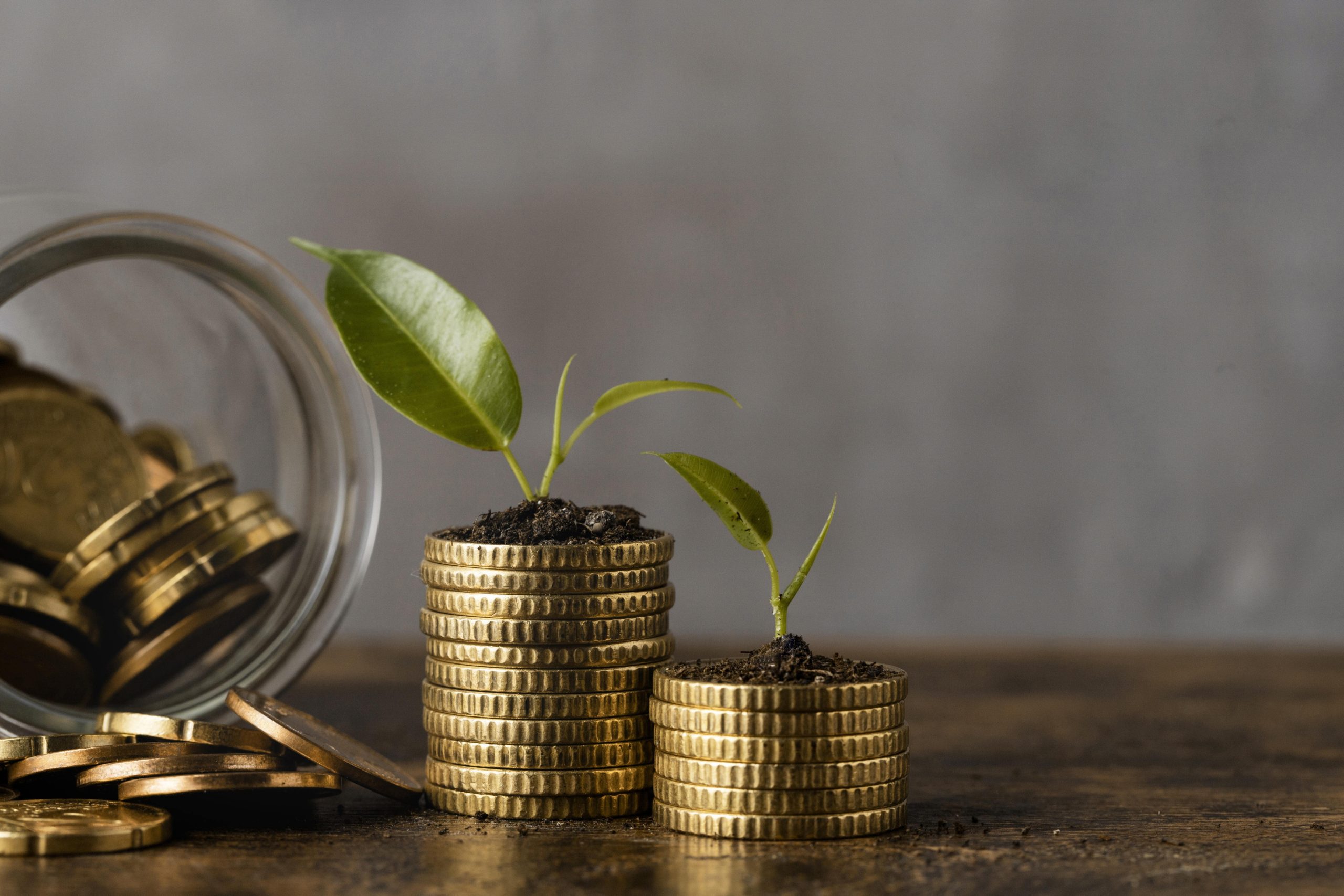
Permanomics: Reframing economic systems for sustainable communities
This presentation was delivered to the 2023 Australian Permaculture Convergence on Peramangk Country, Mount Barker, South Australia. The following is a text version of the presentation including a number of the slides shown. For a recorded version including all the slides, see the embedded video at the end of this page.
Acknowledgement of Country
I would like to start by acknowledging the Peramangk People as the traditional custodians of the land on which we meet today. I pay respects to their elders past and present and honour their unbroken and unceded sovereignty of these lands.
I also pay my respects to the Dja Dja Wurrung people on whose land I currently live.
I am from Aotearoa New Zealand and back home we have a whakatauki or a proverb “ka mua, ka muri” which translates to mean “we walk backwards into the future”. This proverb took on a whole new meaning for me when I migrated to a place where we share the land with the oldest known culture on the planet. There is an infinite depth of wisdom carried by people who can occupy an entire continent for tens of thousands of years with the lightest of footprints. I pay my deepest respect to all First Nations people for the depth of their relationship to country that our language frankly doesn’t have the words for.
Introduction
My name is Rayna Fahey. My background is in parliamentary politics and policy, the not-for-profit sector, grassroots activism, and sustainable agriculture. I first came across permaculture about 15 years ago through my local group, Permaculture Out West. Through POW my family set up a community seedling nursery called POWer Plants. Our business model was to sell enough to cover the cost of seeds and beer for our volunteers. We grew enough seedlings for a monthly sale and donated the rest to local schools and community groups. After I was diagnosed and treated for a serious illness, our family decided to pack up and spend 6 months on the road journeying Australia. It was a wonderful experience and hempcreted our feelings that it was time to move to the country.
We have settled in Drummond on Jaara Country in Central Victoria on a piece of land we have named Windfall Commons.
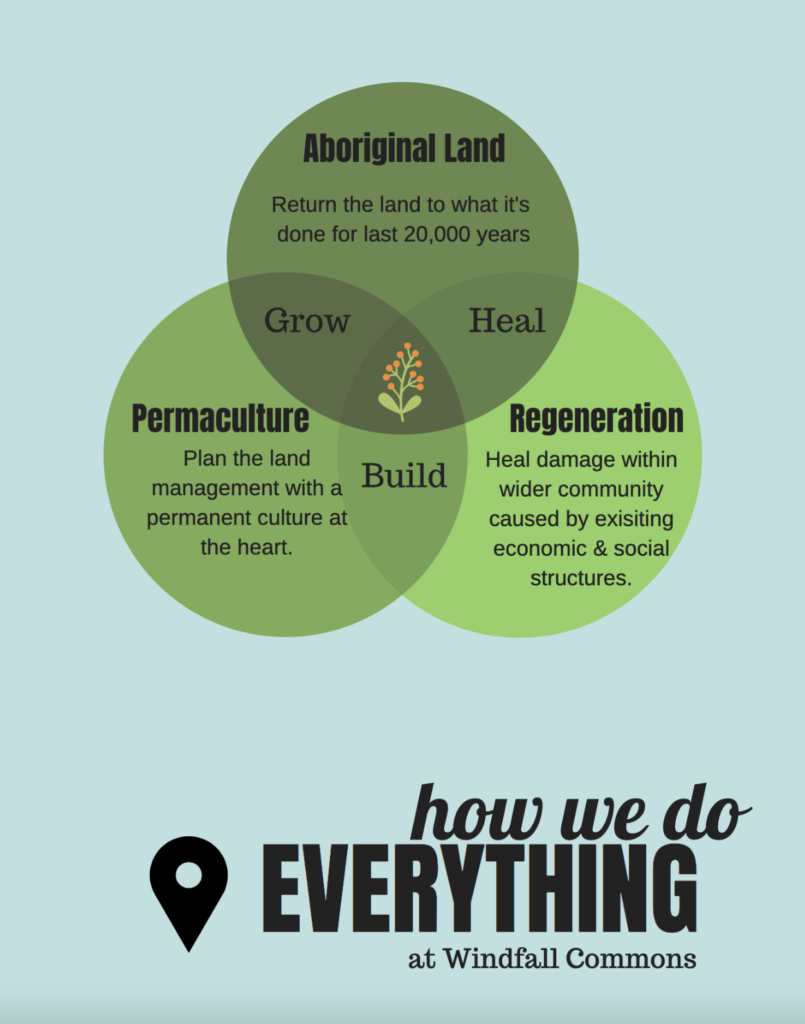
We are working to share the bounty of our land based on principles of decolonisation, regeneration, and strategic design.
Throughout my work and activist life, I have been a passionate advocate for economic reform. As a strategic and structural thinker, I have always been intrigued by the rules of the game. As a young activist, it was pointed out to me by a much wiser head than mine that the rules of politics were really the economic rules. That started a lifelong journey of learning that has led to some fascinating places, even a husband!
When I was first starting out in the world of politics I heard the Thoreau quote:
“There are a thousand hacking at the branches of evil to one who is striking at the root.”
I resolved to spend my life aiming for the root. So today I am here to talk about permanomics which I consider to be a fantastic example of this quote in action. Permanomics isn’t about fixing up a broken system, it’s about asking what are the features of a well-designed system? What are the best and most effective ways to put those features into action?
In this presentation, I will walk us through some of the ways we can apply permaculture design tools to economic system design and help understand why an economic justice approach to community action is critical for permaculture to succeed as a transformative practice.
Jargon(e)
I want to start this presentation by declaring a tiny non-violent war on jargon. Economists love jargon as it makes them feel smarter, and I would argue, helps them further disconnect their theories from the natural world. It’s a big contributor to what’s got us in this mess that our species finds ourselves in. So in this presentation, I am going to do my best to avoid economic jargon, and where I have to use it I will translate it.
In saying all of that I am going to start today with a little economics history lesson, to contextualise this discussion.
What is economics?
Economics is the social science that studies how we make choices about how to allocate resources. It involves the analysis of how goods and services are produced, distributed, and consumed.
Economics understands how we interact in markets – both formal and informal – to exchange goods and services, and how pricing works to coordinate these interactions. It also looks at how government policies, such as taxes and regulations, affect economic outcomes.
Overall, economics seeks to understand and improve the functioning of economies in order to promote greater prosperity for individuals and societies.
In other words, economics is the study of how we value stuff, how we swap stuff, and how wealthy that makes us.
There are various families of economic theories and they all reflect the dominant social ideas of their times. I would like to explain a couple of the main Western theories that have an impact today.
Classical economics
Classical economics emphasises the role of free markets in allocating resources and determining prices. It holds that individuals acting in their own self-interest will naturally produce the greatest economic benefit for society as a whole.
Classical economics also focuses on the concept of comparative advantage, which means that countries should specialise in producing the goods and services that they can produce most efficiently, and trade with other countries to obtain the goods and services they can’t.
Another key idea in classical economics is the labour theory of value, which means that the value of a good or service is determined by the amount of labour that goes into producing it.
Neoclassical economics
Neoclassical economics builds on the ideas of free markets and the price system, but adds the concept of marginal utility. This means that the value of a good or service is not determined by the labour that went into producing it, but rather by the additional utility or satisfaction that the good or service provides to the consumer. In other words. the value of a thing is not just how much it costs to make but also how it makes us feel.
Neoclassical economists also emphasise the role of supply and demand in determining prices, and the importance of competition in ensuring efficient allocation of resources. They believe that market forces will naturally lead to efficient outcomes, with prices and quantities adjusting to balance supply and demand.
Both classical and neoclassical economics focus on price setting and profit. But neither of them differentiates the internal and external costs of production. Nature is seen as a “free” resource.
Both classical and neoclassical economics consider land as a factor of production, along with labour and capital. But they treat them quite differently. In classical economics, land is seen as a generator of value known as economic rent. In contrast, neoclassical economics views land as just another resource and focuses on the role of supply and demand in determining land prices. This distinction is a critical factor to explain why we have such a major issue with land prices now but I’ll discuss that further on.
Classical economics: Production = Land + Labour + Capital
Neo-classical economics: Production = Labour + Capital
Ecological economics
In the latter half of the 20th Century, the field of ecological economics was born, which explicitly stated that the economy was a subset of the earth and not the other way around. In other words, no economy on a dead planet. While there is now a large body of work that has come from this school of economics the impacts have been minimal as we can see by the power extractive capitalism still holds on our economic system.

Permaculture
So if economics is about resources and understanding how we value and exchange them, how does permaculture come into it?
My understanding of permaculture is that it is a framework for analysis and design. The ethics and principles of permaculture are fundamentally about understanding energy flow within an ecosystem and working towards improvements where humans work with nature instead of against it, in order to create abundance.
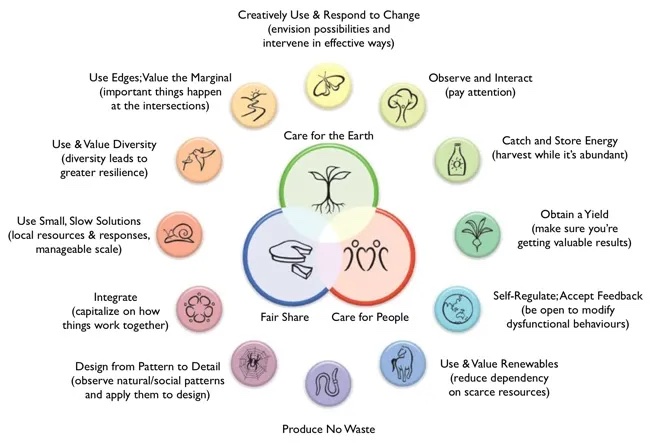
Just like a garden, an economy is an ecosystem. So when we talk about economics, what are the energies involved? The movement of goods, services, people and the things they need to survive, financial capital, and natural resources are the main energies, but there are others.
Principle #1: Observe and interact
So, we all know this one: permaculture design principle #1 observe and interact. How do we observe in economics? Mostly through the scintillating method of statistics, and other fun metric-based methodologies. In all of the economic theories I discussed earlier, they make value-based decisions by what is and isn’t counted, and how it is counted.
I want to outline a couple of examples as to why this is important for understanding permanomics.
The GDP
In her seminal work “Counting for Nothing” feminist economist and former MP from Aotearoa Marilyn Waring CNZM, describes the development of the System of National Accounts (SNA). In Britain, after WWII, the government needed to understand what state the economy was in beyond their own books, including how much people were earning and spending. This system was standardised internationally in 1953. The end result of this process is the calculation of a nation’s Gross Domestic Product (GDP).
The GDP is an incredibly important number to governments and it is used as one of the major benchmarks against which we assess how well our economy is performing. In fact, I will refer to it in this presentation.
Unfortunately, the GDP is incredibly flawed.
In Waring’s work, she explains how the accountants who came up with this method had to figure out what they were going to count as production and what they weren’t. And in doing so they created a “Boundary of Production”.
On one side there was everything with a market exchange. On the other side was everything else. These blokes decided that everything we did with a transaction was going to count as productive and everything else was just leisure.
So what doesn’t count? Parenting, housework, volunteering, exercise, growing your own food. That’s all stuff we do purely for leisure according to the GDP.
Another example is breastfeeding. If I feed a baby formula bought from the supermarket that is an economic activity and the GDP is happy. If however, I breastfeed my baby this is not counted as a contribution to our national economy. There have been multiple studies to try and value breastfeeding. The most recent attempt in Australia values breastfeeding – which lactating women spend on average 22 hours a week doing – at $3B per year. That is equivalent to 6% of all agriculture. But in our SNA it’s counted as leisure.
And here’s the rub, the SNA does factor in some things without a transaction. For example, if you own your own home, it works out how much you would pay if you were renting it and assigns a value to that as an economic activity.
It’s almost as if the men who designed this whole system simply didn’t see what women contribute to the economy as valuable. Spoiler alert: they didn’t.
Another major flaw of the GDP is that there is no negative side of the ledger. If I cut down a forest or plant one, the GDP does not care, it only cares if I got paid or not to do so. Natural disasters? Amazing for the GDP.
So why is this such a problem? Because our governments use GDP to inform so much of their decision-making when they could be making use of other tools.
System of Environmental-Economic Accounting
One such tool is the System of Environmental-Economic Accounting (SEEA). The SEEA is an international statistical standard that had its genesis as a satellite system of the SNA. The SEEA is a way to measure and track how the economy interacts with the environment. It helps us understand how natural resources, like water, land, and air, are used and how they impact economic activities, such as agriculture, manufacturing, and transportation.
The biggest weakness of the SEEA is that it doesn’t include social factors as that’s not what it sets out to do. But if it did it could be an even more useful and holistic tool.
The Australian Government has been using SEEA since the early 2000s releasing the first set of accounts in 2002. Since that time the ABS has continued to develop the SEEA for Australia and in 2018 released the first full set of accounting tables. However, and this may be unsurprising to everyone in this room, under the Morrison Government all work on this project appears to have ceased. The last data release was in July 2021 and no further release dates have been set.
Time Use Surveys
Another tool and one strongly advocated by Waring is the use of Time Use Surveys to assess what we do. One of the major benefits of Time Use Surveys is that they fairly value unpaid labour.
What do you think is the largest sector in the Australian economy? Let’s ask the GDP:
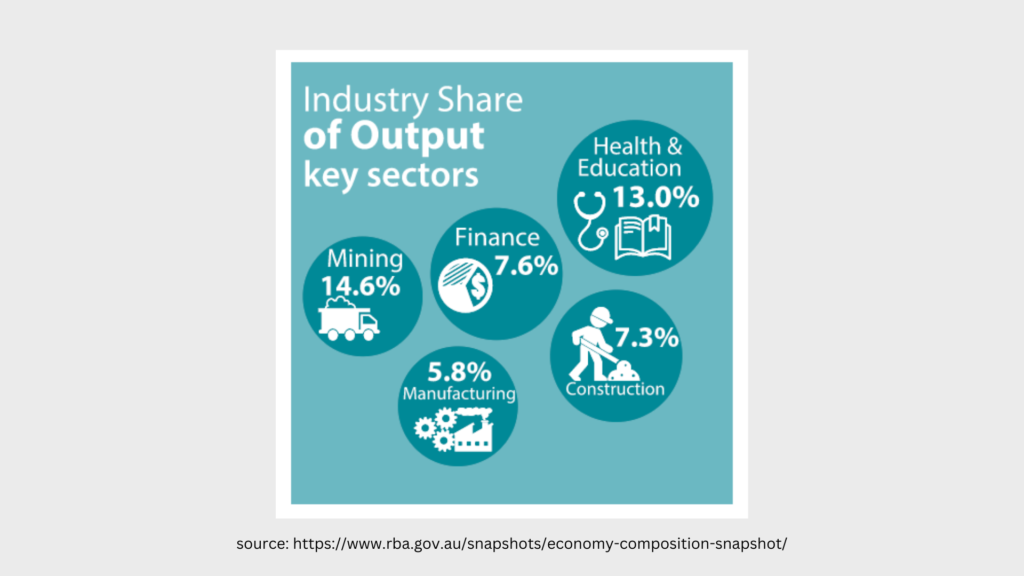
But if we use Time Use Surveys, the largest sector in the Australian economy is unpaid childcare, and the second largest sector is all of the rest of the unpaid work. In NZ the last time use survey showed unpaid childcare worked out to be 2 million jobs at 40 hours a week. At the time 1.7 million people were in full-time employment. Our economy wouldn’t exist if it wasn’t for the billions of hours of unpaid labour that it depends upon.
As Marilyn says:
“As a policy maker, you cannot make good policy if the single largest sector of your economy is not visible. You can’t presume to know where the needs are. You can’t locate time poverty, you can’t address the most critical issues of need.”
Australia has undertaken four comprehensive Time Use Surveys since 1992 including one during the pandemic. In March the Treasury Minister announced that from 2024 we will be undertaking TUS’s on an annual basis. This is great news.
As a permaculture designer, I believe the idea of time analysis is critical to understand. It is already one we use a lot when it comes to landscape design, through the application of zone theory. We design and layout gardens based on how often we use certain spaces and where to locate them in order to most efficiently integrate design elements into our lives. We don’t put the herb garden at the end of a long driveway by the letterbox.
Can you imagine how our system of planning would transform if we centred the needs of our largest sector of workers?
Gross National Happiness
A final observation tool that I wish to discuss that is in practice, but has only had limited uptake is the concept of a Gross National Happiness which was originally conceived in Bhutan. Based on the philosophies of Buddhism, the GNH is designed to measure the collective happiness and well-being of the country. Whilst a nice idea in theory the biggest criticism of Bhutan’s GNH is that it’s “well-being-washing” of quite an awful government who are accused of doing some terrible things to their people.
The idea itself does have some merit and other jurisdictions have been picking it up. Most notably in 2019, the NZ Government announced their first ever Wellbeing Budget which committed to putting people’s wellbeing and the environment at the heart of their policies. One of the main tools developed is the Treasury Department’s Living Standards Framework which not only measures individual but also collective well-being. While not technically a GNH the LSF is a truly groundbreaking piece of work and we should expect to see more uptake of LSFs across the world over the coming years.
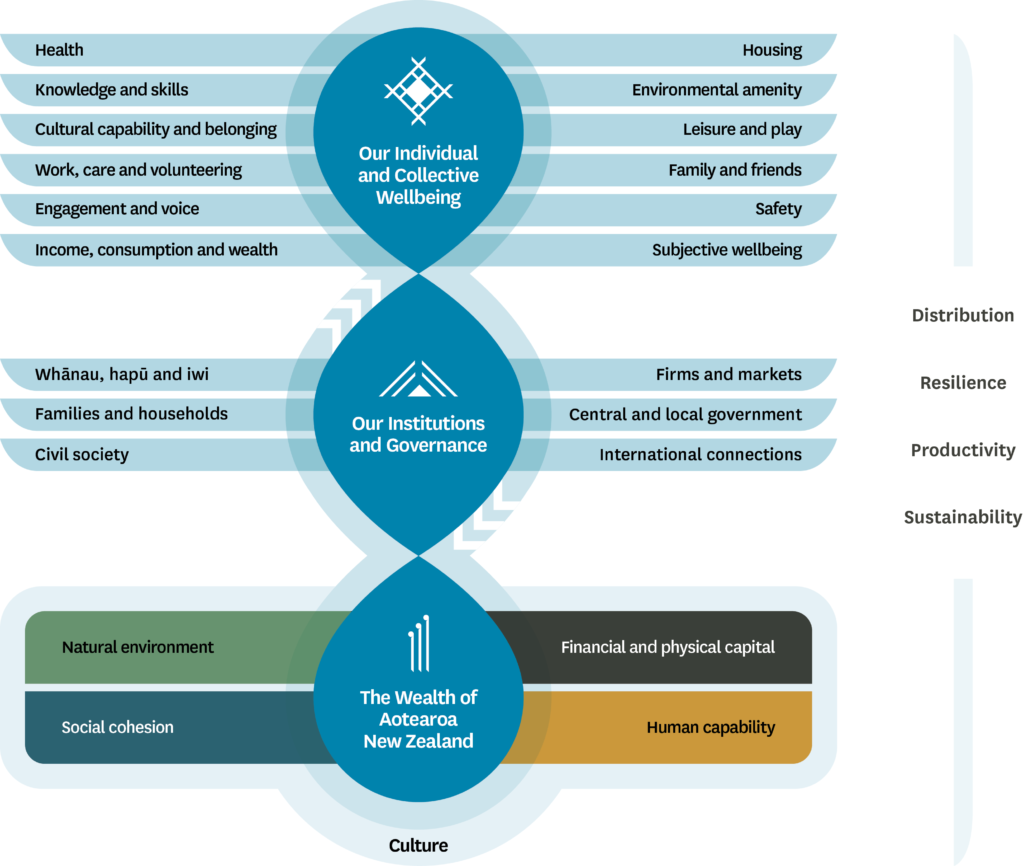
The Commons
The second story I want to tell about what we count and what we don’t is about The Commons.
The enclosure of the commons is a process that took place in England between the 16th and 19th centuries, where common lands were taken over by wealthy landowners and converted into private property. As a result, many people lost their traditional rights to use and benefit from common lands, which had previously provided them with important resources such as food, pasture, firewood, and building materials. The enclosure of the commons played a major role in the transformation of English agriculture and the growth of capitalist modes of production.
Over the last few centuries, the expansion of colonialism across the globe saw rapid commons enclosure as the default practice of Western imperialists.
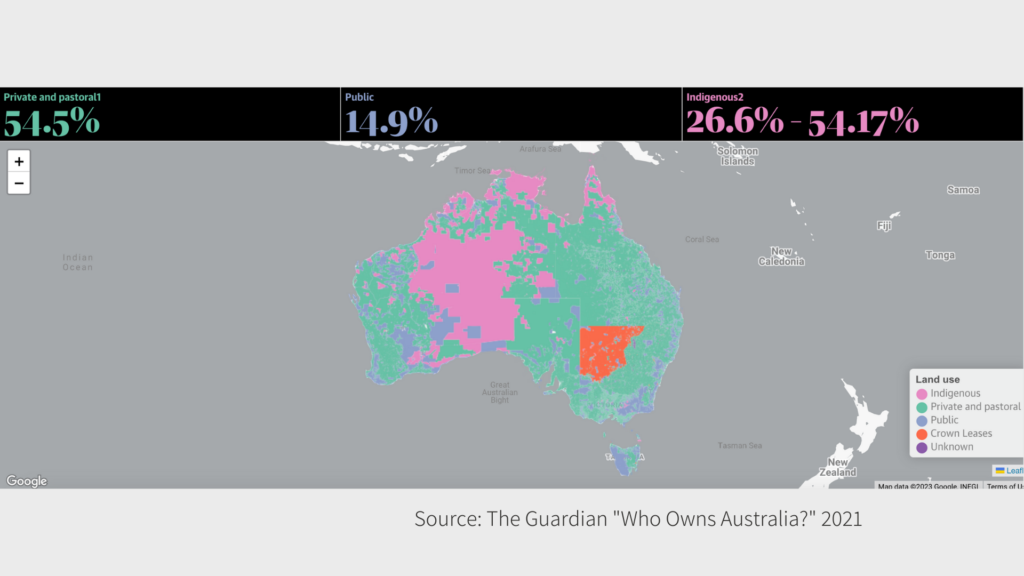
In the space of just over 200 years over half of this continent has been enclosed and sold off to private title. 15% of Australia is public land but almost all of that has no traditional commons access for example National Parks.
The effect of the enclosure of the commons is that the vast majority of European cultural practices around commons management have been lost or distorted to the point of uselessness. There are numerous examples of First Nations cultural practices that demonstrate ways of being that are based on right relationships with the earth including the concept of totem animals and responsibility here in occupied Australia and the idea of kaitiakitanga which loosely translates to guardianship for Maori.
The enclosure of the commons is one of the most devastating policies our species has ever conceived. Private land tenure is a major impediment to successful permaculture design as it is antithetical to natural resource flow. Private land tenure creates a significant power imbalance between those who own it and those who don’t. So as permaculture designers, it is important that we ask the question “Who owns the land?”
So to recap we currently have an economic framework that is driven by the sale of stuff, especially violent and polluting stuff. The sale of stuff leads to the health or otherwise of our economy. And we assess that economy based on some pretty weird frameworks. Overall our economy is largely underpinned by the concept of private property ownership.
Earned vs unearned income
Another economic idea that I would like to outline and that is how we generate wealth. There are two major ways that wealth is created: production and speculation.
Production is the making and growing and building and designing of stuff and ideas.
Speculation is the purchase of a resource – natural or otherwise – holding onto it for a bit and then selling it at a higher value.
Economists refer to these as earned vs unearned incomes.
As I discussed earlier neoclassical economics doesn’t treat speculation as different to production, it’s all just income. But the problem is that speculation and production have two very different economic and social outcomes. In particular, speculation of land is problematic as artificially drives up the value of land to the point the market price of land has very little to do with its actual value. Furthermore, neoclassical economists who argue that price is demand-driven fail to recognise a key difference about land: you can’t make any more of it. There is always a demand because of gravity and increasing population. But there is not a corresponding increase in supply. There is however the largely unchecked ability to buy and hold onto the supply and not do anything with it. There is plenty of evidence to show how common this practice is in Australia.
Growth
Now I promised not to include too much jargon but here comes one more which is the one term with the least to do with the natural world: Growth.
Gardeners know there are two types of growth: growth of the plants you want and growth of the plants you don’t. A garden chocked full of plants is no use to a person if you can’t eat any of it, you can’t move through it, and it’s ugly. Economists on the other hand will tell you that your garden is great!
So economic growth is about the volume output of goods and services. It’s not totally tied to GDP but they are related. Remember how I said earlier that the neoclassical economists got it wrong about land? This is one of the key areas where it’s important. In our growth calculations, increasing land prices are seen as a sign that there are lots of new houses being built. More new houses must be good because that means more stuff is being built and more people are working. They don’t factor in the impact of speculation on prices.
In Australia, land price is one of the biggest contributors to inequality. The haves and have-nots are largely differentiated by whether they have a property portfolio or not. The lack of adequate controls on our property industry means that investment in land is the easiest and fastest way to grow your wealth. However, investment in land has a detrimental effect on our communities as it drives up prices and creates social problems such as homelessness. A report released by the Everybody’s Home campaign a couple of weeks ago showed that there are “no regions of Australia where a single full-time essential worker, such as those in aged care, early childhood or nursing, could afford to rent by themselves.” None.
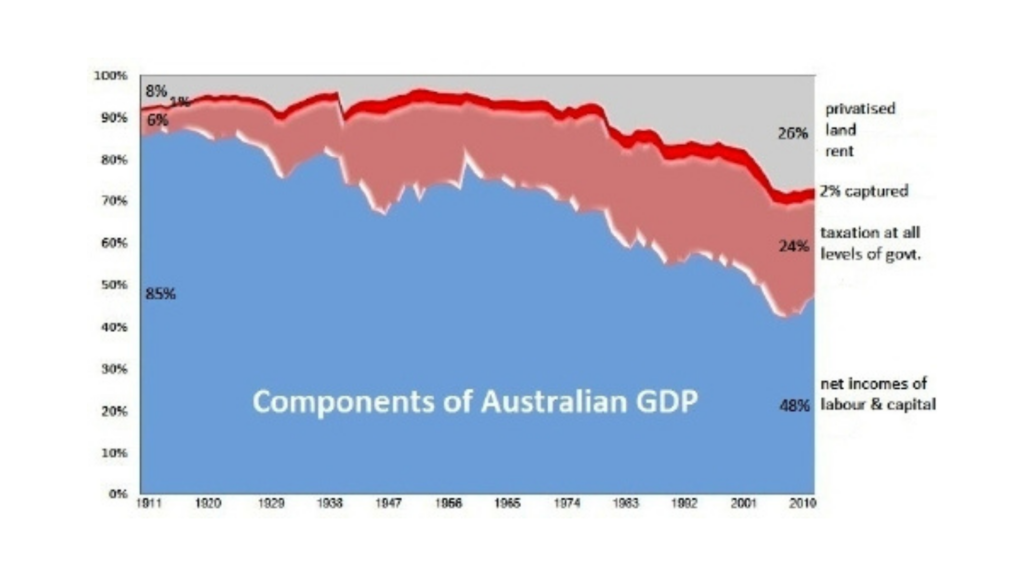
This is a big issue for our economy because as this chart shows over the last century private land has gone from being 8% of our GDP to 26%. As problematic as the GDP is, this data still shows us that a quarter of “production” in this country isn’t being generated by making things, it’s by gaining income from the other people making things, looking after people, growing food etc etc. and profiting from their need to have somewhere to live. This is treated as an unquestionable right by many including our politicians.
Over the course of the pandemic, Australians made massive sacrifices to protect each other. Whole sectors had to undergo significant transformation in order to continue to exist. But one, not so little sector had a grand old time. You can guess where this is going, yep the property sector. In the 2020/21 FY while people were losing their jobs and businesses, and parents were busy juggling working from home with remote learning, the value of land in Australia went up – wait for it – 1.7 Trillion dollars. The highest annual increase on record. So sacrifices were experienced, but certainly not equally.

According to growth figures, this is great! Land prices going up means more houses are being built right? Wrong, the construction figures do not account for this increase in value. But what the latest report from the Australia Institute shows us is that 93% of economic growth between the 2009 financial crisis and the covid pandemic went to the wealthiest 10% of Australians. Wages are stagnating, profits are up, land prices are skyrocketing.
So to recap, we have privatised the commons of our land, through tax levers ensured that land owners pay less tax, seen land rent become a much greater share of our GDP, and now essential workers are priced out of not just the homeownership market, but also the rental market. In a country that prides itself on everyone having a fair go, something is pretty amiss.
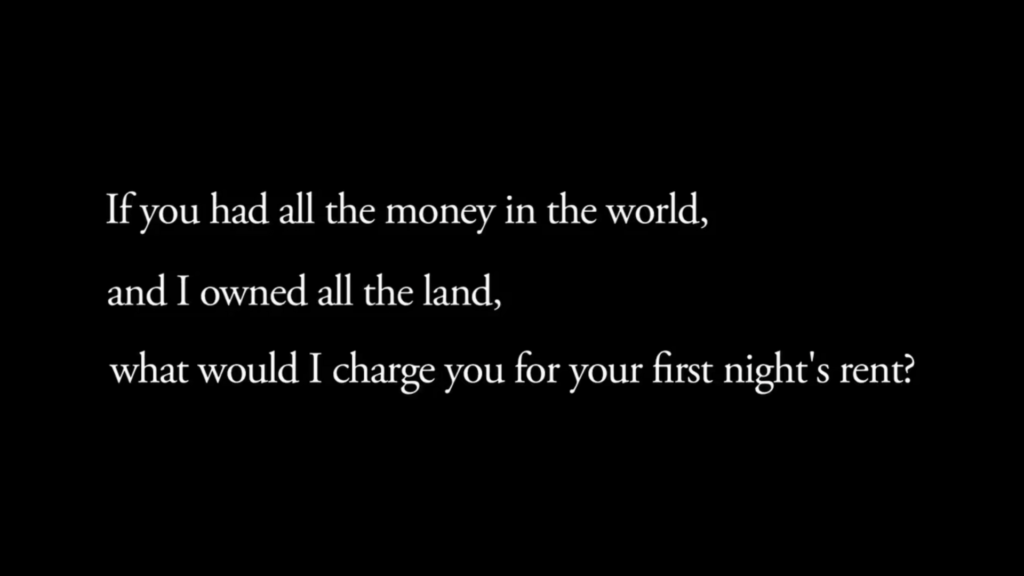
To add to this cheerful outlook, the commons is historically understood as land but over the last century, we have come to understand that we have many public assets that can be understood as being in the commons such as fisheries and forests, knowledge, space, and even our DNA. Many of these commons are being enclosed yet the community is not being consulted or compensated for these enclosures. Some of these enclosures aren’t even happening in our jurisdiction but global trade rules or geography mean they must be applied here. This is a huge issue for small countries that have little or no say in these issues.
The plot is almost always the same: when a commons acquires commercial value, someone tries to grab it. In the old days, that meant politically connected individuals; nowadays, it means politically powerful corporations. What’s astonishing about these takings isn’t that they occur, but how unaware of them the average citizen is.
Karl Fitzgerald
Bill Mollison once said:
“The greatest change we need to make is from consumption to production”
I deeply agree with Bill that consumption culture needs to be radically transformed but I would argue that the greatest change we need to make is from speculation to production. But this is a much harder battle to win.
Impact of patriarchy, colonisation, and globalisation
Alongside the enclosure of the commons, in English history we saw the beginning of colonisation. In the 15th Century, the Catholic Church’s Doctrine of Discovery was a legal principle that asserted that Christian nations could claim the lands of non-Christian peoples. This principle was used to justify European colonization and the dispossession of Indigenous peoples around the world.
Importantly colonisation globalised an ethic that resources have been put on earth for humans to exploit. This has created a culture of first in, first served, again within the misguided idea that resources are infinite and private property rights are paramount.
This has created what Robyn Wall Kimmerer has described as a
“fictional pyramid of human superiority over other species”
So this brings us to today the world has been “discovered” our economy has been globalised and as a species we are starting to look beyond the boundaries of our biosphere for the next frontier of wealth generation.
Classical and neoclassical economics were developed during a time when international trade was slow and expensive. However, with the advent of globalisation and the dominance of multinational corporations, the previous belief that countries should specialise in producing products based on resource availability is no longer relevant. Production location is now largely driven by production costs, and countries with lax labour and environmental laws can provide the cheapest products. Neocolonialism isn’t looking for new lands to enclose and people to enslave, it’s looking for new land to pollute and labour to exploit. And now it does it using algorithms.
Scientists have told us over and over for decades that we face an existential threat to our climate and the latest IPCC report has said this is it; last chance. Where has our current economic framework got us? Radically increased wealth inequality and environmental degradation. History shows that the market is flawed, and government is flawed, but we need both in some form as a system of exchange and a system of governance.
Where to from here?
I find permaculture design exciting because this is a tool that we can use to understand the energy flows within a system and figure out ways to identify harness and distribute abundance. Despite what the Malthusians would have us believe there is more than enough wealth to go around. And thanks to the last few centuries of extraction there is more than enough resources on our surface to go around. What we have is a distribution crisis.
What can permaculture offer?
Permaculture emphasizes a regenerative approach to resource management that values long-term sustainability over short-term gain. This means designing economic systems that minimize waste and pollution, conserve natural resources, and support local communities.
Most of the conversations held in the public arena about climate change focus on all of the things we would have to give up in order to combat climate collapse. But the majority of these conversations are based on a premise that we continue within our current consumption-driven economic framework.
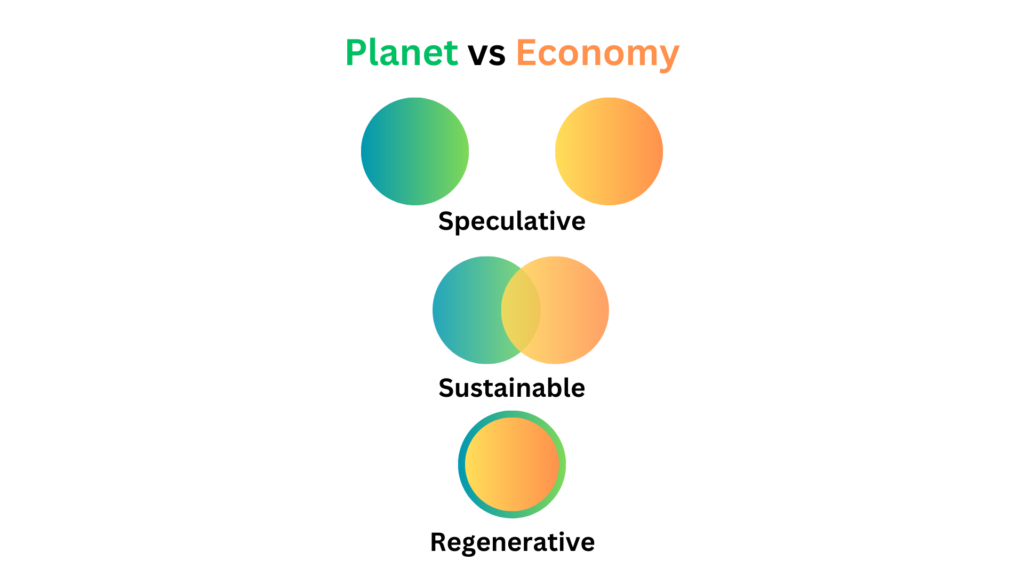
But what would happen if we re-framed our economic framework from a system of speculation, hoarding and greed to a system based on abundance distribution and care?
How do we move to an economic system that not only holds sustainability at its core but actively regenerates the land? We can move from the economics of greed to an economics of abundance for all.
With a permanomics approach, I like to reference the work of the wonderful Ro Morrow who is here at the APC this year:
- Ethics are universal
- Principles are global
- Strategies are bioregional
- Techniques are local
Our first step is to rethink the jargon.
Tax
Now I want you all to stick with me here because I’m about to start talking about the most boring word in the English language: tax. Remember what I said at the beginning about economists weaponising jargon against us? Tax is the number one. So when I say “tax” instead what I want you to hear is “sharing” because that’s what tax is. We pool our resources and collectively meet the needs of our community. It is fairer and more efficient. What isn’t fair and efficient is the way we collect our taxes.
Going back to the beginning tax was paid to The Monarch or whoever by the landholders in exchange for the protection of the army and things like roads, but generally, people built all of their own infrastructure.
Over the centuries and with the development of a more “representative” democracy, taxes began to pay for more and more. We worked out as a society that we get greater value when we collectivise infrastructure. Things like schools, hospitals, libraries, public transport, biosecurity; you name it – it is better value for individuals if we collectively manage these assets.
What we don’t have is a system where those who gain the most value from the commons, pay their fair share. There is a natural collector of revenue and it’s not the tax office, it is the land itself. When a community becomes desirable the land becomes more valuable. The creation of land value wealth is community created and it should be harnessed and used to pay for community assets. However, since the 17th century landowners have progressively convinced governments that we should tax workers, and more recently goods and services, instead of the land.
But again this is a problem with our neoclassical economic framework that doesn’t see land value as its own special category. As permaculturalists we get it. We understand the importance of access to land because we know what abundance the land can produce but we regularly face power imbalance of the haves and have-nots in our own projects and it is critically important that we understand the wider mechanics at play when designing our projects. Even though we can’t generally reform the economic system through a grassroots permaculture project, understanding who’s going to benefit from them should be an important part of our people care ethic in action. Being transparent and accountable about the problems we are trying to solve and the ones we can’t, shows we are able to see the greater forces at play in our transformative work.
I like to think of land value like water. Water falls on the landscape and we can capture and store it for future use in various ways. We can channel it to where we need it the most and away from where it can be a problem. But landowners have a responsibility to the whole river system and we have regulations to ensure enough water continues to enter river systems to maintain a healthy ecological balance.
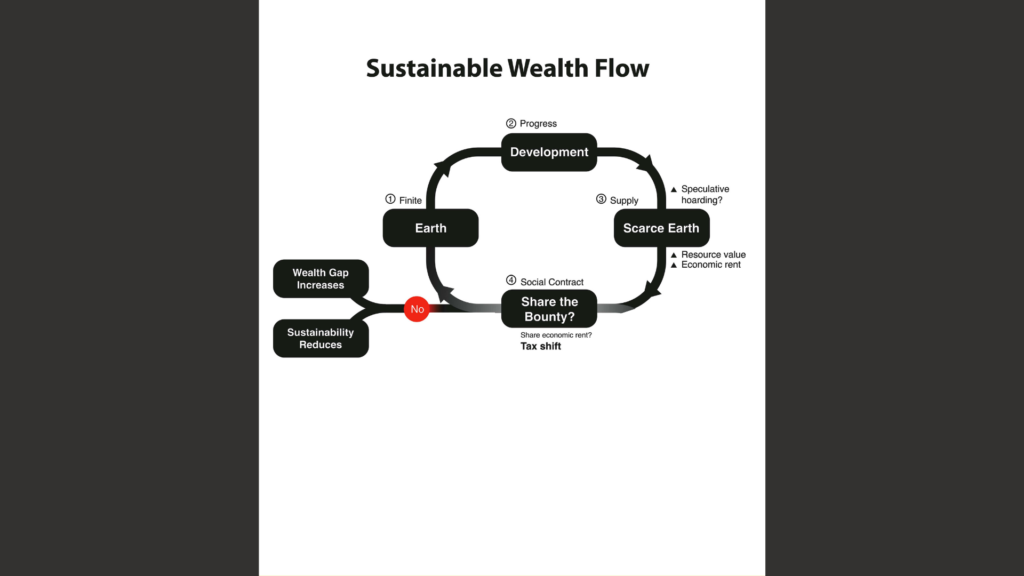
Likewise, community-created wealth collects naturally and is captured in the form of land value. So what happens when as is the current situation in Australia we don’t collect this value? This leads to increased inequality. As the people earning the money to pay for rent aren’t seeing any of this value coming back to them, it is all going into the pockets of landowners and their banks.

Going back to our chart showing Australian land values and the rise in total land values we can see that there is abundant growth and aside from a couple of small corrections, the trend is definitely upwards.
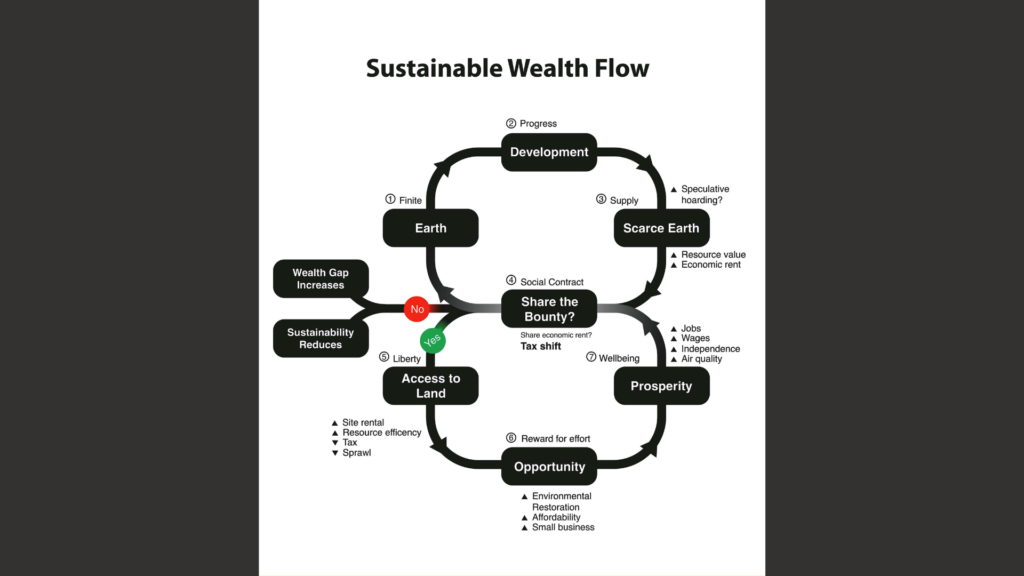
If we capture some of that land value and return it to the community in the form of land taxes and rates that value can be recycled back to the community that created it. I think this is a great example of Bill Mollison’s concept of mobilising earnings for the widest benefit.
If we don’t collect some of this wealth to recycle it’s like putting a pipeline from your water tank at the top of the property and diverting it straight out the bottom. When we consider how many landlords don’t live in the same community as their investment properties that pipeline can lead straight out of town, draining wealth away to never be seen again. Given the increasing volume of corporate investors in land, especially agricultural land, much of this value heads directly offshore.
So what are the solutions?
Earlier I spoke about the Living Standards Framework, which is an excellent development. But it is mostly about counting what has already happened. To an extent it directs the way government spends its money but it has little to do with how that revenue is collected.
I also discussed how tax can be another word for sharing. It can also be another word for behaviour management.
Revenue and behaviour
Taxation has significant effects on people’s behaviour, as it changes the incentives that people and businesses face when making decisions. By taxing certain activities or products, governments can discourage those behaviors, while also generating revenue. This can be much more effective than banning things.
For example, a tax on carbon emissions can encourage individuals and businesses to reduce their carbon footprint by using cleaner energy sources. A tax is more efficient than a trading scheme as the tax disincentivises the carbon from being extracted in the first place whereas a trading scheme just means the carbon is only available to companies willing to pay the price.
However, it’s important to note that taxes are not always the best solution. They can be regressive, meaning that they can disproportionately affect low-income individuals who may not have the resources to invest in more environmentally friendly options. What’s important is that they tax the relevant part of the extraction cycle. It’s counterproductive to place congestion charges on commuters when you’re offering tax breaks to oil companies.
Earlier I spoke about earned versus unearned income. Tax works in a similar way. If we tax productive behaviour we make it harder for people to make their own income and employ people. If on the other hand, we tax unearned income from natural monopolies like land and resources we encourage the efficient use of those resources and discourage their hoarding. Access to land is one of the critical energies in the economic ecosystem.
So this all sounds good in theory, right? In practice, it is a massive battle because we don’t actually live in a representative democracy. We are governed under a version of the Westminster system which was originally developed as the voice of the landlords. Nowadays our representative system would be better described as a lobbyocracy as the day-to-day decision-making work of politicians – no matter how well-intentioned they are – is heavily influenced by lobbyists. The investment in campaign contributions can result in returns thousands of percent higher if a favourable decision is made. The worst companies are the ones that spend the most on lobbying.
Here in Australia, we need to do much more work to track donations for decisions but if you want a gut-wrenching read, check out the book Game of Mates by Queensland economists Cameron Murray and Paul Fritjers.
The greatest example in our recent history of what happens when politicians start talking about significant economic reform was in 2010. Kevin Rudd’s government introduced a proposal for a Mining Resource Rent Tax which aimed to generate revenue by imposing a 40% tax on mining profits.
The proposed tax was met with fierce opposition from the industry and some state governments, who argued that it would damage the industry and result in job losses. The mining industry launched a massive campaign against the tax, which had a significant impact on public opinion.
This tax was based on the simple premise that mining companies are generating enormous profits from resources that belong to all of us and therefore they should share some of the profits with us all as well. Nothing brings out the lobbyist big guns like a threat to unearned income. Not only did the reforms fail, the PM lost his job.
Any mention of land tax reform by a politician is guaranteed to elicit a small army of lobbyists from the property lobby ready to correct your misguided views… Sadly there isn’t much of a lobby on the side of positive economic reform. But the more we talk about economics within progressive communities like the permaculture movement the more the concepts underpinning justice-based economics will be understood by our political representatives and they won’t be so swayed by lobbyists.
So let’s talk about the solutions.
Let’s stop for a moment and consider just how much wealth there is in our economy, concentrated in the hands of a few and what abundance could be created if that wealth was to move more freely.
There is a global movement of economic reformers who advocate for what’s known as an Earth Rights Democracy. Based on three key reforms:
- Land tax – We should shift taxes off production and onto speculation.
- Resource Rents – Income generated from state-granted monopolies should contribute to general taxation.
- Public ownership of all monopolies – State-granted monopolies – be they natural or created, should always be in public ownership.
These three macro-level policies are permanomics in action. All of the permaculture ethics and principles can be demonstrated through these policies.
Citizen’s Dividends
When we harness community-created value this opens up the possibilities for progressive citizens’ dividend programs. There is a growing movement of people advocating for concepts like a Universal Basic Income. The idea is that it is more cost-effective for the government to default pay everyone a basic living allowance and carve back money off people who don’t need it through taxation than it is to deliver welfare under our current model. This concept has serious merit but with a big but. It is critical that a UBI is funded by land taxes to close the loop of the value that it will create.
There are a couple of fantastic examples of nations socialising wealth into what’s called a sovereign wealth fund. The two main examples are the Norwegian Sovereign Wealth Fund and the Alaska Permanent Fund. The latter pays an annual citizens’ dividend to everyone. The last payment was $1114 each.
These principles can also apply at the community level and don’t need to simply apply to financial wealth.
Community Land Trusts
My favourite community-level example of Earth Rights is a Community Land Trust. Currently, most land is covered by a fee-simple title system. You pay cash upfront (normally borrowed from the bank) and you own the land and buildings (or the bank does). When you decide you don’t want the land anymore you can sell it and the difference in value is known as capital gains.

Under a CLT model, the land is instead owned by a Trust and you buy the house as your upfront cost. Instead of paying for the land upfront, you pay an annual site rental back to the trust. In most instances, the amount you pay for your house and land will end up being comparable to a traditional mortgage but instead of those payments heading off to the bank and its shareholders, that wealth goes back to the trust to reinvest in community-owned housing. Over time this approach ends up being much cheaper for the individual and the benefits of land custodianship are shared beyond the fence line.
Community Land Trusts are becoming more common overseas and in particular in the US and the UK. One of the biggest and most established CLTs is the Champlain Housing Trust in Burlington Vermont. Founded in the 1980s when Bernie Sanders was the Mayor, Champlain has hundreds of properties owned by the community for the purpose of affordable housing. Champlain is so big that it’s impacting the wider real estate market as the influence of speculation in their market is so dampened. When the GFC hit, Burlington had the lowest impact out of any US city.
CLTs are a new idea in Australia and since we have a high regulatory environment they are quite a challenge to establish. But I urge anyone interested in this model to check out grounded.org.au an organisation recently established to establish and advocate for CLTs here. It was founded by the previously mentioned economist husband of mine 🙂
One of my favourite small-scale examples of resource rents is a seed bank. When you borrow seeds from a bank there is a social contract in place that at the end of the season, you save some of the seeds and return them back to the bank, ensuring the continuity of that commons.
8/9 forms of capital
Seed banks are an example of a permanomics approach to capitals. Ethan Roland & Gregory Landua from Apple Seed Permaculture in the US have done some really important work around reframing capital through their work on regenerative economics. They argue that financial capital is only one form of capital that contributes to the holisitic wealth of an individual. The other 7 are:
- Intellectual
- Spiritual
- Social
- Material
- Ecological
- Cultural
- Experiential
They hold that the wealth of a person can only be accurately measured by taking all of these things into account. And it follows that all of these capitals can be drawn on in different ways at different times. If we use and value diversity we can see that if we just have a lot of one or two of these capitals we won’t be as wealthy as having a moderate amount of all of them.
I have one significant criticism of the 8 forms of capitalism and whenever I teach this concept I add a further capital and that is health. Physical and mental health are incredibly important forms of capital and make a definite qualitative impact on a person’s life.
Throughout this presentation, I have largely focused on structural questions of permanomics. But there are also actions that can be taken at an individual level.
Take Action
After you have contacted your local MP and talked to them about the importance of reforming our economic systems, here’s a couple more things you can do:
- Divest and invest – spending your money is like making lots of little votes. That includes who you bank, insure, and invest with. Get your money into ethical funds, make sure they are ethical! Divest from speculation and invest in some great local businesses instead.
- Buy Local – this is my favourite economic policy and I have been campaigning for local purchase preferencing since I first ran for council over 20 years ago. Every dollar you spend locally helps strengthen your local economy. Buying local creates jobs, is more environmentally friendly, and has greater flow on effects to local organisations.
These actions are powerful indeed but if we want to establish a permanent culture we need to engage in the wider rules of engagement. We need to reboot the operating system that underpins our economic and political decision-making. While I do deeply believe in the radical potential of permaculture design to transform our lives, without the systemic changes we need, the ecological and social destruction that we see on a daily basis will only continue to worsen.
Permanomics isn’t a set of tools for individual action, it is a framework for global earth rights justice. It is not enough to just have a vote for our future but the time has come when we also need a fair share.
“So, we can’t save the world by playing by the rules, because the rules have to be changed. Everything needs to change and it has to start today.”
Greta Thunberg